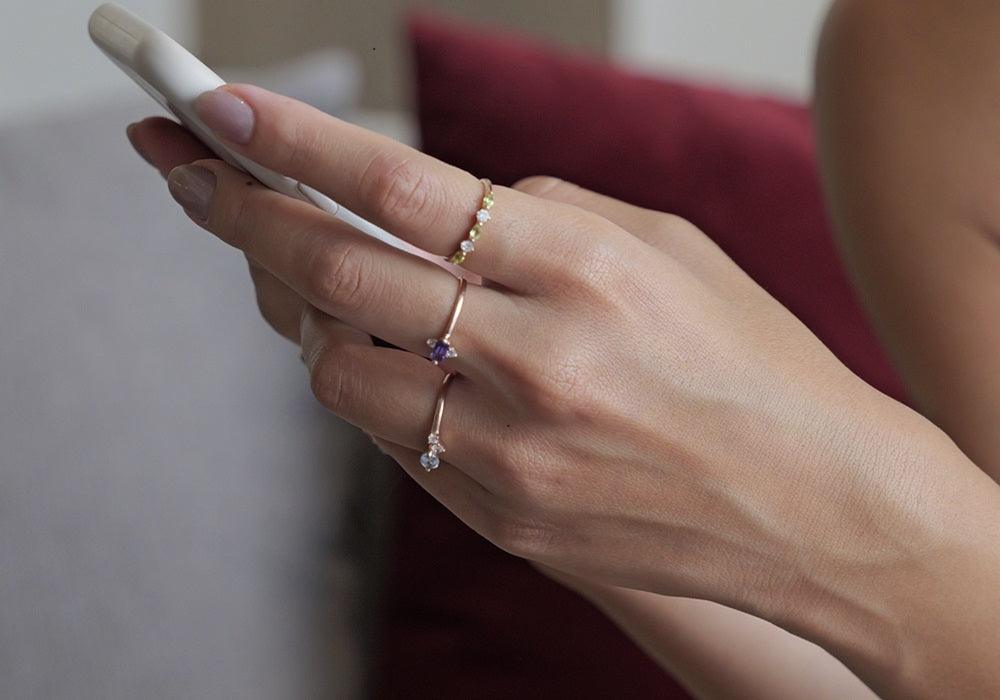DIAMOND SIZE CHART
Did you know that a diamond can be measured in weight (Carat Weight) and size (Millimeters)?
Even though the price is set in accordance with its carat weight as it is a standard unit of measurement for diamonds, it is also important to consider its size and ratios to ensure that you receive the best diamond possible, worthy of your budget.
Measurement in millimeters is an indicator of the diamond’s true size. Diamonds with the same carat weight can have different cuts and widths. Some shapes may appear larger even though they are made from the same carat size.
JEWELRY SUGGESTIONS
Diamond Shapes

Round
Based on a 2020 survey from The Knot, round-cut diamonds continue to be the most popular shape. Used in engagement rings, with 43% of the respondents stating they have a round-cut diamond. Round diamonds are said to sparkle the most compared to other diamond shapes. It makes them more expensive than other shapes.
Princess
Princess-cut diamonds are said to be the second most popular diamond shape. A nice sparkle and shine like the round-cut diamond, but square in shape. This diamond shape is generally less expensive than the round-cut diamond of the same carat weight. They have the flexibility to work in many ring styles.
Emerald
Emerald diamonds are rarer than round or princess-cut diamonds, but they are also in less demand, making them generally less expensive per carat than round diamonds. This cuts generally come in a rectangle form but can be available in squares, too. This shape is perfect for those looking for a larger diamond at a more affordable cost.
Cushion
Cushion-cut diamonds have a similar look and feel to the square-cut diamond, but its soft edges give it a more romantic feel. This shape has larger facets than a round-cut diamond, making cushion-cut diamonds appear slightly bigger when viewed from the top. However, they will not sparkle as much as the round-cut diamond.
Asscher
Asscher-cut diamonds are square in shape and feature cut corners, making it technically an octagon, but unnoticeable to the untrained eye.
To allow the most amount of light to enter and reflect, it's best to put an Asscher-cut diamond in a four-prong setting. Keep in mind, that the higher the prong you have to increase brilliance, the higher the risk you have of snagging the diamond.
Radiant
Radiant cuts became popular in the 1980s. Its square shape is a nice bridge between a cushion and a princess cut. The shape looks beautiful in a set with rounded or square-cornered diamonds.
According to experts, radiant cut is one of the least expensive diamond shapes, in terms of cost per carat. Because of its design, the radiant-cut diamond requires more carat weight in the depth to maximize brilliance.
Pear
Pear-shaped diamonds (also known as teardrop) are unique because they are a combination of a round and marquise cut, giving them a timeless, vintage look. They came into the jewelry scene in the 1400s but have made a recent comeback in jewelry trends.
Diamonds in pear shape can come in a variety of widths and have the added bonus of making the wearer's finger appear longer and slimmer. Traditionally, the wearer should have the point of the diamond directed out toward the fingernail.
Marquise
Marquise-cut diamonds feature 58 facets and an elliptical shape with pointed ends.
Carat for carat, this shape has one of the larger surface areas of any diamond, so if you're looking for maximum size, the marquise cut might be for you. This type of cut is also used for other gems like emeralds, rubies and sapphires.
Oval
This shape has been around for a while, with the first mention of the oval diamond cut occurring in 1304. The stone resembles traits of the round cut but is a little more unique. The oval can be set in either a wide or slim set, depending on personal preference.
Since the oval shape has no sharp corners, it's less prone to chipping. If you like the rounded look without the price of a round-cut diamond, an oval-shaped cut might be for you.
Heart
A heart-shaped diamond represents love and romance. This type of cut is popular in pendants, engagement rings and promise rings. When looking at heart-shaped diamonds, make sure the diamond is symmetrical, as that's a very important characteristic, otherwise the heart will look off.
Interested in seeing how each of these diamond shape sizes compare to one another in carat size? Use this Diamond Carat Size Chart to see how the 10 most popular diamond shapes compare as the carat weight increases. You might be surprised by the visual differences with each diamond face shape!


